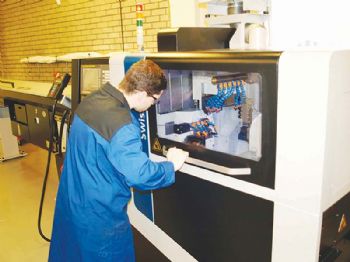
Mildenhall-based CTPE Ltd was established by the current managing director Chris Taylor in 1989, some 12 years after he completed an apprenticeship with a manufacturer of scientific instruments.
The company, which specialises in components made from plastics and non-ferrous metals, has recently been adding to its machine tool portfolio. CTPE had been running with five CNC vertical machining centres and three fixed-head turning centres.
However, when one of the company’s multinational health-care customers began to introduce JIT manufacturing, along with weekly delivery schedules and monitored performance (relating to quality and delivery), it decided to look at machining technology that could more readily meet these requirements. The result was its first CNC sliding-head turning centre.
Mr Taylor said: “To meet demand we were setting up the same batch of about 200 plastic turned parts on our fixed-head machines perhaps twice a month, simply because we didn’t have the time to produce larger and more-economical batch sizes. As a result, we started to look at sliding-head machines as a way of increasing our capacity and throughput.”
CTPE looked at four major suppliers of sliding-head machines, undertaking what the company describes as “an in-depth evaluation”. This resulted in the purchase of a Tornos Swiss DT 26 from Coalville-based Tornos UK Ltd (
www.tornos.com).
Cutting fluids
Highlighting one of the factors that influenced this purchase, Mr Taylor said: “Historically, we have used water-based soluble cutting fluids, which have never given any problems with cleanliness, carry-over or adverse effects on our plastic materials.
However, some sliding-head suppliers did not want to run their machines with soluble coolant, only neat cutting oil; the Tornos Swiss DT 26 has been developed for use with either soluble coolant or neat cutting oil.
Furthermore, we could buy the 26mm-capacity Swiss DT 26 for around the same price as most 20mm-capacity machines from other suppliers. We also appreciated the fact that this machine offers 10kW of power on both the main spindle and the sub-spindle.”
Although most of the parts made to date by CTPE on the Swiss DT 26 have been machined from plastic, it will not always be that way. Indeed, the company has already machined a number of aluminium components on the machine since it was installed in October 2016.
Mr Taylor says he also appreciates the ease and speed with which the machine can be switched from guide bush to non-guide bush operation.
“A lot of our parts are short, so the ability to switch between the two modes in just 15-25min is very useful, it can save money on tooling and bar wastage.
“In guide-bush mode, the bar end is generally longer than in non-guide bush mode, which reduces it to around 65mm; this increases the number of parts we can machine from a bar — and gives a significant saving when we are turning costly plastics such as PEEK.”
Machining tolerance
As well as PEEK, CTPE uses its DT 26 to machine acetal, PTFE, PVC, nylon 66 and Rulon, as well as 2024 aluminium — and some parts require tolerances in the region of 10µm.
Mr Taylor says: “We have found that the Tornos machine will hold 5µm all day long, so dimensional accuracy is not an issue. In fact, the machine is far more sturdy and repeatable than our fixed-head machines, which means — for the first time — we can run unmanned when-ever demand dictates, safe in the knowledge that parts will be produced to specification while we are not here.”
The DT 26, which can produce components up to 200mm long, is paired with a Tornos Robobar SBF 326 (3.2m capacity) bar-feeder for unmanned production.
As standard, the machine offers six turning tools, four driven radial tools, an angle tool post that allows the use of four tools each for front and back machining — plus four independent positions for use with the counter-spindle, all with the ability to use live tools.
Furthermore, the modular concept of the Swiss DT 26 means that its configuration can easily be adapted to meet differing requirements.
At CTPE, the machine typically produces parts in batches of 1,000- to 2,000-off, but Mr Taylor says the ease and speed with which the machine can be set up means it is equally economical to run batches as small as 300- to 400-off.
On average, the parts produced by CTPE are around 20mm long and 15mm in diameter.
A typical cycle time is 20sec, although particularly complex components can take up to 50sec. “Compared with our fixed-head turning centres, we’ve seen some cycle times reduced from 150sec to just 30sec.
“Moreover, some of those fixed-head parts will still require a second operation, not to mention deburring and ‘picking out’. We have none of those tasks with our sliding-head machine. Furthermore, its design ensures effective swarf management, which is vital when machining plastics.”